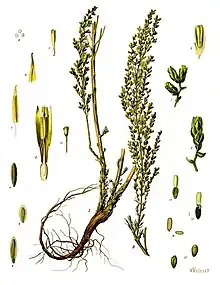Artemisia cina
Artemisia cina, commonly known as santonica (zahr el shieh el -khorasani), Levant wormseed, and wormseed, is an Asian species of herbaceous perennial in the daisy family.[2][3] Its dried flowerheads are the source of the vermifugic drug santonin since ancient times.[4] Its common names arise from its known ability to expel worms. The powder is grayish-green in colour with an aromatic odour and a bitter taste. Dysphania ambrosioides is another plant with the common name wormseed, called epazote in Mexican cuisine.[5]
| Artemisia cina | |
|---|---|
 | |
| 1897 illustration[1] | |
| Scientific classification | |
| Kingdom: | Plantae |
| Clade: | Tracheophytes |
| Clade: | Angiosperms |
| Clade: | Eudicots |
| Clade: | Asterids |
| Order: | Asterales |
| Family: | Asteraceae |
| Genus: | Artemisia |
| Species: | A. cina |
| Binomial name | |
| Artemisia cina Berg & C.F. Schmidt ex Poljakov | |
The plant is characterised by its spherical pollen grains, which are typical in the Asteraceae; a fibrous layer on anthers; lignified, elongated, hypodermal sclerids; and clusters of calcium oxalate crystals.
It is native to China, Pakistan, Russia, Turkestan, Kazakhstan, and Kyrgyzstan.[6]
It is referenced in the short story “Funes the Memorious” by Jorge Louis Borges.
Biochemistry
In addition to santonin, the above-ground parts of the plant contain betaine, choline, tannins, pigments, and an essential oil. The essential oil is largely composed of 1,8-cineole, but contains a wide variety of other compounds as well.[7] Cineole takes its name in part from the specific name, cina.
References
- 1897 illustration from Franz Eugen Köhler, Köhler's Medizinal-Pflanzen
- Berg, Otto Karl 1959. Darstellung und Beschreibung samtlicher in der Pharmacopoea borussica aufgefuhrten offizinellen Gewachse 4(29): chapter 29c
- The International Plant Names Index
- Grieve, Maud (June 1971). A Modern Herbal (Volume 2, I-Z and Indexes). Dover Publications. ISBN 978-0-486-22799-3.
- Tina Danze, The Dallas Morning News. 1998. Mexican Magic: Epazote's Special Flavor
- "Artemisia cina". Germplasm Resources Information Network. Agricultural Research Service, United States Department of Agriculture. Retrieved 21 January 2018.
- Zh. K. Asanova; E. M. Suleimenov; G. A. Atazhanova; A. D. Dembitskii; R. N. Pak; A. Dar & S. M. Adekenov (January 2003), "Biological Activity of 1,8-Cineole from Levant Wormwood", Pharmaceutical Chemistry Journal, 37 (1): 28–30, doi:10.1023/A:1023699012354, ISSN 1573-9031, S2CID 27081377